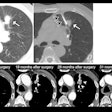Researchers in Germany have raised the question of whether a fixed upper age limit may be justified for performing endovascular thrombectomies (EVT) to treat the oldest elderly stroke patients, according to a study published August 12 in JAMA Open Network.
Based on an age-based analysis, the group found dramatically lower rates of independent ambulation and higher mortality in patients older than 80 who underwent EVT compared with younger patients.
“The question arises whether these extremely poor functional outcomes might justify the application of a fixed upper age limit for endovascular thrombectomy in acute ischemic stroke with large infarct,” wrote lead author Laurens Winkelmeier, MD, of the University Medical Center Hamburg-Eppendorf in Hamburg.
Acute ischemic stroke is a leading cause of disability and death worldwide. With populations in Europe, North America, and parts of Asia rapidly aging, cases of acute ischemic stroke are expected to increase over the next decades, the authors noted.
EVT is a minimally invasive image-guided surgical procedure used to dissolve blood clots in stroke patients, and thus restore blood flow (reperfusion) to prevent further brain damage. Recent clinical trials have provided robust evidence that the procedure improves functional outcomes among patients with large vessel occlusion (LVO), the authors wrote.
However, data on EVT safety and efficacy in the oldest elderly patients who have experienced LVOs remain scarce, despite the fact that this subgroup is frequently encountered in acute stroke treatment, they noted.
To address this knowledge gap, the group compared safety and efficacy outcomes in 126 patients older than 80 and 282 patients ages 80 and younger. Patients received EVT for acute ischemic stroke with large infarct at one of 25 German stroke centers between May 2015 and December 2021. Primary outcomes of the study were independent ambulation and mortality rates after 90 days.
According to the analysis, the rate of independent ambulation decreased from 56.4% in patients 60 years and younger to 15.1% in patients older than 80 (p < 0.001), while mortality increased from 15.4% in patients 60 and younger to 64.3% in those older than 80 (p < 0.001).
However, successful reperfusion in patients was associated with higher rates of independent ambulation (adjusted odds ratio, 4.95), regardless of age and without significant interaction (p = 0.27), the researchers reported.
“Importantly, a poor clinical prognosis does not generally preclude the treatment effect of an intervention," the group wrote. "An upper age limit might simplify acute management and free up capacities of endovascular thrombectomy, but it would also underestimate the heterogeneity of aging across individuals."
In other words, under specific conditions, patients older than 80 could have a better clinical prognosis than younger patients receiving EVT for large ischemic stroke, the researchers wrote. The findings ultimately add insights for the subgroup of patients older than 80 who are underrepresented in randomized clinical trials, but frequently encountered in clinical practice, they explained.
“Endovascular thrombectomy for acute ischemic stroke with large infarct should not be withheld based on an upper age limit," the team concluded. "Age should be integrated within a multimodal approach to individualize treatment decisions in these highly affected patients with stroke."
The full study is available here.



















